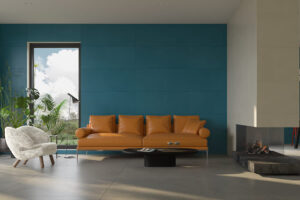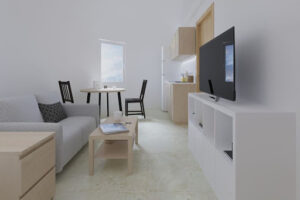In the ever-evolving world of interior design, visualization has emerged as a transformative tool. Gone are the days of relying solely on sketches and swatches to convey design concepts; instead, technology has ushered in a new era of virtual visions. Interior design visualization, once a niche practice, is now at the forefront of the industry’s future. In this comprehensive exploration, we’ll delve deep into the exciting realm of interior design visualization, uncovering its past, understanding its present, and envisioning the remarkable future it promises with the expertise of YouSee Studio, a leading rendering studio in the field.
The Evolution of Interior Design Visualization
From Sketches to Pixels: A Historical Perspective
The journey towards the future of interior design visualization begins with a look back. We’ll explore how interior designers transitioned from hand-drawn sketches and physical models to the digital realm. Discover the key milestones that paved the way for today’s sophisticated tools and techniques.
The Rise of 3D Modeling and Rendering
The advent of 3D modeling and rendering marked a turning point in interior design visualization. Dive into the significance of these technologies and how they have revolutionized how designers and clients interact with design concepts. We’ll also discuss the role of software applications like SketchUp, Blender, and AutoCAD in this transformation.
The Present State of Interior Design Visualization
Crafting Photorealistic Renderings

Today’s interior designers have access to a dazzling array of tools to craft photorealistic renderings of their projects. We’ll delve into the techniques to achieve stunning visualizations that provide clients with a lifelike preview of their future spaces.
Immersive Virtual Reality (VR) Experiences

Virtual Reality has taken interior design to new heights. Learn how VR technology is harnessed to create immersive experiences where clients can virtually step into their envisioned spaces, exploring every detail before a piece of furniture is moved.
The Future Beckons: What Lies Ahead
Artificial Intelligence (AI) and Machine Learning
The future of interior design visualization is intrinsically linked to the growth of AI and machine learning. We’ll explore how these technologies are poised to assist designers in generating design ideas, optimizing layouts, and even predicting trends based on vast datasets.
Augmented Reality (AR) Integration
AR is set to blur the lines between the physical and digital worlds. Delve into how AR integration will allow designers to overlay virtual design elements onto natural spaces in real time, enhancing collaboration and creativity.
Sustainable Design Visualization

As sustainability becomes increasingly vital, interior designers turn to visualization to explore eco-friendly design options. We’ll discuss how visualization tools are aiding in creating sustainable interiors that are both aesthetically pleasing and environmentally responsible.
The Future of Interior Design Visualization: Challenges and Opportunities
Visualization has become increasingly prominent in the rapidly evolving landscape of interior design. In the first part of our exploration, we journeyed through the history of interior design visualization, examined its present state, and delved into the exciting technologies shaping its future. Now, in the second part, we will navigate through the challenges and opportunities that lie ahead for interior designers and the fascinating world of design visualization.
Challenges on the Horizon
1. Data Security and Privacy Concerns
Data security and privacy concerns are rising as interior design visualization becomes more reliant on digital tools and cloud-based platforms. Designers need to be vigilant about protecting sensitive client data and intellectual property. The challenge lies in finding a balance between convenience and security.
2. Integration Complexity
The plethora of design software, 3D modeling tools, and VR/AR applications can lead to integration challenges. Designers may grapple with compatibility issues when transferring data and models between different platforms. Streamlining these processes is essential for a seamless workflow.
3. Technical Expertise
While technology offers incredible opportunities, it also demands technical expertise. Designers must continually update their skills to leverage the full potential of advanced tools. Bridging the knowledge gap is a significant challenge, especially for those transitioning from traditional methods.
4. Cost of Technology
Investing in cutting-edge technology, such as high-end rendering workstations or VR headsets, can be costly. Smaller design firms or independent designers may find it challenging to compete with larger companies with substantial budgets for technology upgrades.
5. Ethical Considerations
The use of AI and machine learning in design raises ethical questions. Designers must grapple with issues like AI-generated designs, which may blur the lines of authorship and creativity. Navigating these ethical considerations while embracing technology poses a unique challenge.
Opportunities on the Horizon
1. Enhanced Collaboration
Advanced visualization tools offer unprecedented opportunities for collaboration. Design teams, clients, and stakeholders can interact with designs in real time, providing instant feedback and fostering more efficient decision-making processes.
2. Sustainable Design
The growing emphasis on sustainability in design aligns with visualization tools’ ability to model and simulate eco-friendly solutions. Designers can easily explore renewable materials, energy-efficient layouts, and sustainable practices.
3. Customization and Personalization
VR and AR technologies empower clients to customize and personalize their spaces extraordinarily. From selecting furniture and finishes to adjusting lighting and layout, interior design becomes an immersive and highly personalized experience.
4. Global Reach
Visualization tools enable designers to collaborate with clients and professionals worldwide. This global reach expands opportunities for projects and partnerships, transcending geographical boundaries.
5. Efficiency and Cost Reduction
While technology may come up with front costs, it often leads to long-term efficiency gains. Designers can iterate and refine designs more rapidly, reducing project timelines and costs. Virtual walkthroughs can also eliminate the need for physical prototypes and mock-ups.
The Human Touch in a Digital World
While technology advances, it’s crucial to remember that interior design remains a profoundly human-centered field. The human touch, creativity, and ability to understand and meet clients’ emotional needs are irreplaceable.
As we journey into the future of interior design visualization, it’s not about the technology itself but how it enhances our ability to create meaningful, beautiful, and functional spaces. The most significant opportunities arise when designers seamlessly merge their artistic intuition with the capabilities of cutting-edge tools.
Conclusion
The future of interior design visualization is a captivating blend of challenges and opportunities. Designers who navigate the evolving technological landscape while preserving their creativity and empathy will thrive in this dynamic field. The fusion of artistry and innovation will continue to shape interior design, bringing forth virtual visions that enrich our physical world.
As we conclude our exploration, we stand on the threshold of an era where virtual and physical realities coexist, ideas become immersive experiences, and the boundaries of creativity are limited only by our imagination. The future of interior design visualization is a remarkable journey into the virtual realms of design.













